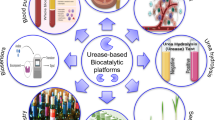Abstract
In this study, urease was immobilized in a polymer network obtained by complexation of poly(1-vinyl imidazole) (PVI) with poly(acrylic acid) (PAA). Preparation of the polymer network was monitored by FT-IR spectroscopy. Scanning electron microscopy (SEM) revealed that enzyme immobilization had a strong effect on film morphology. Proton conductivity of the PVI/PAA network was measured via impedance spectroscopy under humidified conditions. Values of the Michaelis-Menten constant (K M) for immobilized urease were higher than for the free enzyme, indicating a decreased affinity of the enzyme to its substrate. The basic characteristics (pHopt, pHstability, T opt, T stability, reusability, and storage stability) of immobilized urease were determined. The results show that the PAA/PVI polymer network is suitable for enzyme immobilization.
Similar content being viewed by others
References
Arslan, A., Kıralp, S., Toppare, L., & Bozkurt, A. (2006). Novel conducting polymer electrolyte biosensor based on poly(1-vinylimidazole) and poly(acrylic acid) networks. Langmuir, 22, 2912–2915. DOI: 10.1021/la0530539.
Avnir, D., Braun, S., Lev, O., & Ottolenghi, M. (1994). Enzymes and other proteins entrapped in sol-gel materials. Chemistry of Materials, 6, 1605–1614. DOI: 10.1021/cm00046a008.
Bozkurt, A., & Meyer, W. H. (2001a). Proton conducting blends of poly(4-vinylimidazole) with phosphoric acid. Solid State Ionics, 138, 259–265. DOI: 10.1016/S0167-2738(00)00779-7.
Bozkurt, A., & Meyer, W. H. (2001b). Proton-conducting poly(vinylpyrrolidon)-polyphosphoric acid blends. Journal of Polymer Science Part B: Polymer Physics, 39, 1987–1994. DOI: 10.1002/polb.1174.
Bozkurt, A., Meyer, W. H., Gutmann, J., & Wegner, G. (2003a). Proton conducting copolymers on the basis of vinylphosphonic acid and 4-vinylimidazole. Solid State Ionics, 164, 169–176. DOI: 10.1016/j.ssi.2003.09.005.
Bozkurt, A., Meyer, W. H., & Wegner, G. (2003b). PAA/imidazol-based proton conducting polymer electrolytes. Journal of Power Sources, 123, 126–131. DOI: 10.1016/S0378-7753(03)00560-3.
Chellapandian, M., & Kirshan, M. R. V. (1998). Chitosanpoly (glycidyl methacrylate) copolymer for immobilization of urease. Process Biochemistry, 33, 595–600. DOI: 10.1016/S0032-9592(98)80001-0.
Dhawan, G., Sumana, G., & Malhotra, B. D. (2009). Recent developments in urea biosensors. Biochemical Engineering Journal, 44, 42–52. DOI: 10.1016/j.bej.2008.07.004.
Günday, S. T., & Bozkurt, A. (2008). Preparation and proton conductivity of polymer electrolytes based on alginic acid and 1,2,4-triazole. Polymer Journal, 40, 104–108. DOI: 10.1295/polymj.PJ2007152.
Kartal, M., Kayahan, S. K., Bozkurt, A., & Toppare, L. (2008). Entrapment of invertase in an interpenetrated polymer network of alginic acid and poly (1-vinylimidazole). Talanta, 77, 659–662. DOI: 10.1016/j.talanta.2008.07.017.
Kartal, M., Kayahan, S. K., Bozkurt. A., & Toppare, L. (2009). The synthesis of complex polymer electrolytes based on alginic acid and poly(1-vinylimidazole) and application in tyrosinase immobilization. Polymer Journal, 41, 46–50. DOI: 10.1295/polymj.PJ2008130.
Krajewska, B. (2009a). Ureases I. Functional, catalytic and kinetic properties: A review. Journal of Molecular Catalysis B: Enzymatic, 59, 9–21. DOI: 10.1016/j.molcatb.2009.01.003.
Krajewska, B. (2009b). Ureases. II. Properties and their customizing by enzyme immobilizations: A review. Journal of Molecular Catalysis B: Enzymatic, 59, 22–40. DOI: 10.1016/j.molcatb.2009.01.004.
Krajewska, B., Leszko, M., & Zaborska, W. (1990). Urease immobilized on chitosan membrane: Preparation and properties. Journal of Chemical Technology & Biotechnology, 48, 337–350. DOI: 10.1002/jctb.280480309.
Kreuer, K.-D. (1996). Proton conductivity: Materials and applications. Chemistry of Materials, 8, 610–641. DOI: 10.1021/cm950192a.
Kreuer, K. D. (2002). On solids with liquid like properties and the challenge to develop new proton-conducting separator materials for intermediate-temperature fuel cells. A European Journal of Chemical Physics and Physical Chemistry, 3, 771–775. DOI: 10.1002/1439-7641(20020916)3:9〈771:: AID-CPHC771〉3.0.CO;2-Y.
Kreuer, K. D. (1998). In: B. V. R. Chowdari, K. Lal, & S. A. Agnihotry (Eds.). Solid state ionics: science and technology. Singapore: World Scientific.
Kuswandi, B., Andres, R., & Narayanaswamy, R. (2001). Optical fibre biosensors based on immobilised enzymes. The Analyst, 126, 1469–1491. DOI: 10.1039/b008311i.
Laska, J., Wlodarczyk, J., & Zaborska, W. (1999). Polyaniline as a support for urease immobilization. Journal of Molecular Catalysis B: Enzymatic, 6, 549–553. DOI: 10.1016/S1381-1177(99)00013-2.
Li, X., Goh, S. H., Lai, Y. H., & Wee, A. T. S. (2001). Miscibility and interactions in blends of carboxyl-containing polysiloxane with poly(1-vinylimidazole). Polymer, 42, 5463–5469. DOI: 10.1016/S0032-3861(01)00015-5.
Lowry, O., Rosebrough, N. J., Farr, A. L., & Randall, R. J. (1951). Protein measurement with the folin phenol reagent. The Journal of Biological Chemistry, 193, 265–275.
Maaref, A., Barhoumi, H., Rammah, M., Martelet, C., Jaffrezic-Renault, N., Mousty, C., & Cosnier, S. (2007). Comparative study between organic and inorganic entrapment matrices for urease biosensor development. Sensors and Actuators B: Chemical, 123, 671–679. DOI:10.1016/j.snb.2006.10.010.
Pozniak, G., Krajewska, B., & Trochimczuk, W. (1995). Urease immobilized on modified polysulphone membrane: Preparation and properties. Biomaterials, 16, 129–134. DOI: 10.1016/0142-9612(95)98275-J.
Raghunath, K., Rao, P. K., & Jozeph, T. K. (1984). Preparation and characterization of urease immobilized on to collagenpoly (glycidyl methacrylate) graft copolymer. Biotechnology and Bioengineering, 26, 104–109. DOI: 10.1002/bit.260260119.
Rao, S. M., Chellapandian, M., & Krishnan, M. R. V. (1995). Immobilization of urease on gelatin — poly (HEMA) copolymer preparation and characterization. Bioprocess and Biosystems Engineering, 13, 211–214. DOI: 10.1007/BF00367256.
Rosen-Margalit, I., & Rishpon, J. (1993). Novel approaches for the use of mediators in enzyme electrodes. Biosensors and Bioelectronics, 8, 315–323. DOI: 10.1016/0956-5663(93)85012-D.
Singh, S., Singhal, R., & Malhotra, B. D. (2007). Immobilization of cholesterol esterase and cholesterol oxidase onto solgel films for application to cholesterol biosensor. Analytica Chimica Acta, 582, 335–343. DOI: 10.1016/j.aca.2006.09.010.
Teke, A. B., & Baysal, Ş. H. (2007). Immobilization of urease using glycidyl methacrylate grafted nylon-6-membranes. Process Biochemistry, 42, 439–443. DOI: 10.1016/j.procbio.2006. 08.012.
Tsai, H.-c., & Doong, R.-a. (2007). Preparation and characterization of urease-encapsulated biosensors in poly(vinyl alcohol)-modified silica sol-gel materials. Biosensors and Bioelectronics, 23, 66–73. DOI: 10.1016/j.bios.2007.03.017.
Yamada, M., & Honma, I. (2004). Anhydrous protonic conductivity of a self-assembled acid-base composite. The Journal of Physical Chemistry B, 108, 5522–5526. DOI: 10.1021/jp030767o.
Author information
Authors and Affiliations
Corresponding author
Rights and permissions
About this article
Cite this article
Şenel, M., Coşkun, A., Fatih Abasıyanık, M. et al. Immobilization of urease in poly(1-vinyl imidazole)/poly(acrylic acid) network. Chem. Pap. 64, 1–7 (2010). https://doi.org/10.2478/s11696-009-0103-x
Published:
Issue Date:
DOI: https://doi.org/10.2478/s11696-009-0103-x




